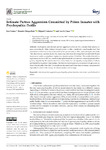Intimate Partner Aggression Committed by Prison Inmates With Psychopathic Profile

Ver/
Use este enlace para citar
http://hdl.handle.net/2183/28137
A non ser que se indique outra cousa, a licenza do ítem descríbese como Attribucion 4.0 Internacional
Coleccións
- Investigación (FDER) [673]
Metadatos
Mostrar o rexistro completo do ítemTítulo
Intimate Partner Aggression Committed by Prison Inmates With Psychopathic ProfileData
2021-05-12Cita bibliográfica
Gómez, J.; Ortega-Ruiz, R.; Clemente, M.; Casas, J.A. Intimate Partner Aggression Committed by Prison Inmates with Psychopathic Profile. Int. J. Environ. Res. Public Health 2021, 18, 5141. https://doi.org/10.3390/ijerph18105141
Resumo
[Abstract] Psychopathy and intimate partner aggression (IPA) are two concepts that usually appear concomitantly. Male violence toward women is often considered a psychopathic trait that sometimes involves the woman’s homicide by her partner and, at other times, attempted homicide. This phenomenon has been studied by conducting interviews following Hare’s model with 92 men incarcerated under a compliance regime in a Spanish prison (Córdoba). The results detected six explanatory factors of IPA as a result of attempted homicide or homicide: criminal past and delinquency, impulsivity, the need to stand out from others, lack of empathy, manipulation of others, and instability in partner relationships. The first two factors predict a occurrence of high scores on Hare’s Psychopathy Checklist. The results are discussed, and future lines of research are presented, especially focused on the concept of dehumanization and revenge
Palabras chave
Intimate partner aggression
Psychopathy
Prison inmates
Condemned
Gender-based violence
Agresión de la pareja
Psicopatía
Reclusos
Violencia de género
Agresión da parella
Violencia de xénero
Psychopathy
Prison inmates
Condemned
Gender-based violence
Agresión de la pareja
Psicopatía
Reclusos
Violencia de género
Agresión da parella
Violencia de xénero
Versión do editor
Dereitos
Attribucion 4.0 Internacional
ISSN
1661-7827






